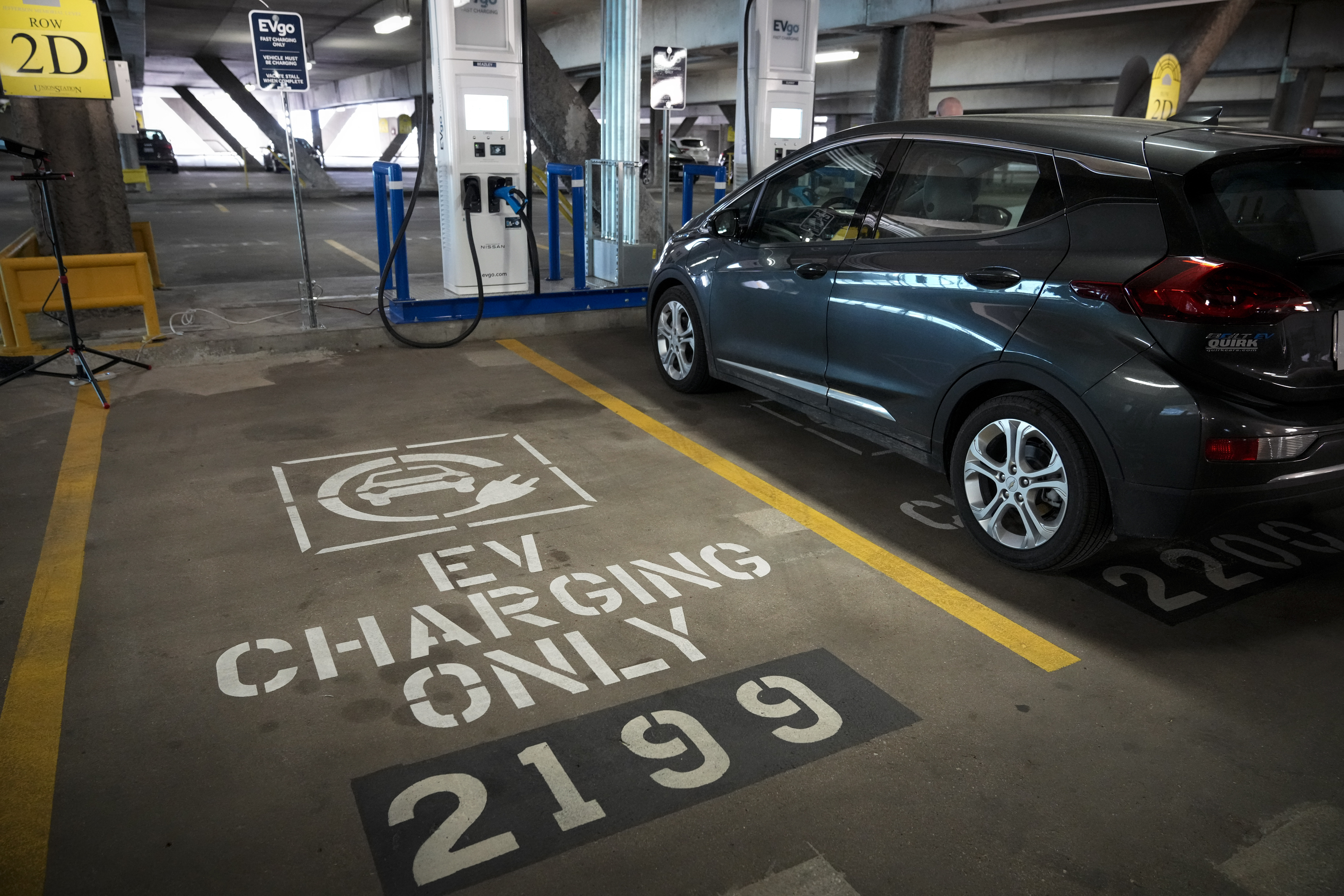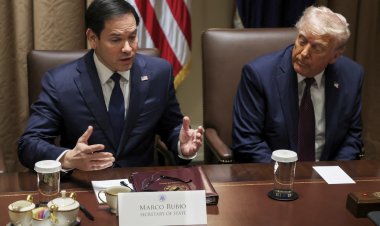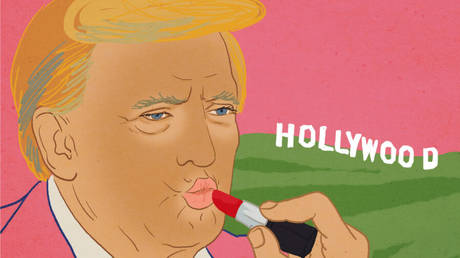Treasury imposes binding rules on tax breaks for electric cars
The restrictions on foreign content will reduce how many vehicles can qualify for the $7,500 tax credit, at least temporarily. But the administration hopes it will bring long-term growth, jobs and energy security to the U.S.


The Biden administration announced rules Friday that will make it harder for many electric vehicles to qualify for federal tax breaks — but could, over the long term, foster the growth of entire new U.S.-based industries based on clean energy.
The Treasury Department proposal aims to carry out one of the most hotly debated provisions of the climate law that President Joe Biden signed last year: its $7,500-per-vehicle tax credit for cars and trucks powered by electricity instead of fossil fuels. The tax incentives have already provoked months of anger from European nations that want a share of the bonanza for their companies, an issue that Friday’s proposal does not immediately resolve.
Treasury’s rules aim to thread the needle between two of the law’s main goals — combating climate change by making electric vehicles more affordable, but also ensuring that the U.S. and its closest trading partners provide the critical parts and supplies to make those vehicles and their batteries. China now dominates the global supply chain for those components.
“We know that in order to meet our energy security, climate and economic goals, we need to build a clean energy supply chain that is not dependent on China,” a senior Treasury official said, speaking anonymously as part of the administration’s ground rules during a call with reporters.
The sourcing requirements will temporarily reduce the number of vehicles eligible for the full incentives, the official conceded. “However, we believe these requirements will significantly increase the number of vehicles made and sold in the U.S. over the next decade as new investments and American production come online.”
For now, though, it’s unclear whether the Treasury rules will prove so restrictive for automakers that it stunts sales of electric vehicles. That would be a major blow to Biden’s goal of having zero-emission vehicles account for half of all new U.S. car and truck sales by 2030.
The department’s list of eligible vehicles is expected by April 18 and will be updated monthly, officials said on the call.
The administration’s early attempts to navigate the climate law’s requirements have drawn accusations from EU officials that the U.S. is applying the made-in-America requirements too restrictively. But some U.S. lawmakers including Sen. Joe Manchin (D-W.Va.) have charged that Biden is offering too much leeway to foreign suppliers, in defiance of the statute.
“It is horrific that the Administration continues to ignore the purpose of the law which is to bring manufacturing back to America and ensure we have reliable and secure supply chains,” Manchin, who wrote much of the law, said in a statement Friday. He called the Treasury proposal “a pathetic excuse to spend more tax payer dollars as quickly as possible,” adding that it “further cedes control to the Chinese Communist Party in the process.”
But the reality is that the climate law has already ruled out the full tax credit for the vast majority of electric vehicles now on the market, the head of one automotive trade group said — and the Treasury guidance will take even more off the table. The question is whether the long-term growth that the administration envisions will come to pass.
"Given the constraints of the legislation, Treasury’s done as well as it could to produce rules that meet the statute and reflect the current market," said John Bozzella, CEO of the Alliance for Automotive Innovation.
What Treasury’s proposal does
The climate law, known as the Inflation Reduction Act, offers a credit of up to $7,500 for electric vehicles that meet stringent production requirements.
For a vehicle to be eligible, at least half of its battery components must be made in North America. In addition, at least 40 percent of the battery’s critical minerals must be either sourced domestically — extracted or processed in the U.S. or recycled in North America — or in a country with which the U.S. has a free trade agreement. Those percentages will increase annually under the law, beginning next year.
Vehicles can qualify for half the credit if they meet either the battery or critical minerals requirement.
The vehicle itself must be assembled in the United States.
Until now, though, U.S. carmakers rushing to develop their domestic supply chains haven’t known exactly how the Internal Revenue Service intends to carry out the law’s sourcing requirements.
Treasury’s guidance was originally due in December, but the department postponed the proposal's release until Friday. In the meantime, it allowed the credit to go into effect without any restrictions on where a vehicle was produced — a move that incensed Manchin. Since January, electric vehicle buyers have been able to receive the credit as long as they did not exceed an income threshold and the car was below a certain price.
In April, the requirements get a lot tighter. The new Treasury rules apply to vehicles picked up by their owners on or after April 17, even though they won’t be final until at least June.
Automakers get some leeway
Now that the guidance is out, automakers must determine how their complex supply chains align with the sourcing rules. The carmakers will certify to the IRS each month which of their vehicle models qualify, and the agency will update a list on its website, the officials said.
The Treasury document offers some olive branches to automakers worried about the rules being overly restrictive.
For instance, the department provided flexibility in how it interprets the IRA’s requirements regarding trade partners and the sourcing of powders contained in battery electrodes. The administration sees this leeway as critical to keeping sales of electric vehicles growing while automakers race to create domestic supply chains.
Some of those interpretations angered Manchin, who in recent days threatened to take the administration to court if it opened the door too much to supplies from abroad.
In contrast, Democratic Rep. Dan Kildee from auto-industry-heavy Michigan told POLITICO last week that he was “looking for the broadest application possible” of the sourcing rules, and was “just hopeful that there isn’t an unnecessary narrowing of the credit to the point that it’s really not substantial.” He said he thought Manchin “may not have fully understood the implications of what that language was going to mean.”
Kildee said he’d support revisiting the language in the law, but that it wasn’t likely to be loosened while Republicans control the House.
“Look, we’ve got two problems,” said his fellow Michigan Democratic Rep. Debbie Dingell. “We can't be dependent upon China. And we’ve got to make [electric] vehicles affordable.”
No quick end to tensions with Europe
In one of the most eagerly anticipated aspects of the guidance, the Treasury Department opened the door for a broader range of U.S. allies to qualify as trading partners under the critical minerals requirement. Those could eventually include the European Union, although the proposal released Friday doesn’t say that explicitly.
Under Treasury’s rules, automakers will be able to obtain critical minerals from the 20 countries with which the U.S. has formal trade agreements, including Chile and Australia, two of the top sources of lithium needed for electric vehicles batteries. The EU has no such agreement with the U.S., so for now it’s excluded.
Canada, Mexico, Israel and South Korea are also on the initial list of countries that can supply minerals for vehicles eligible for the tax break.
But the guidance released Friday also allows countries to qualify for the credit if they have made narrower agreements with the U.S. on trade in critical minerals. Japan signed such an agreement this week, allowing Treasury to add it to its list of approved suppliers.
Trade negotiators from the U.S. and Europe are trying to work out a similar agreement. The two sides hope to complete it by the time Treasury publishes the final guidance.
Manchin said in January that when he crafted the critical minerals language, he was unaware that the U.S. and EU lacked a formal free trade agreement. He said he supports opening the credit to allies — but he draws the line at any interpretation of the law that allows Chinese companies to be involved in the supply chain for eligible vehicles.
In the meantime, automakers including German giant Volkswagen have announced plans to expand in North America, seeking certainty their models will qualify for the incentives.
In 2024 and 2025, the credit will become even more stringent as provisions go into effect prohibiting the sourcing of any battery parts and critical minerals from “foreign entities of concern” — which most likely will include China. That could be a significant new hurdle, given that many top mining companies are partially Chinese-owned or process their minerals in China.
The climate law does not spell out exactly which countries — or companies with partial foreign ownership — would fall under the “concern” label, and automakers were eagerly anticipating such an interpretation as part of Friday’s guidance.
Administration officials said on the call, however, that guidance on the “foreign entities of concern” provision would not be released until later this year. Some industry watchers believe it could align with stringent guidance issued by Treasury last week that defines “foreign entities of concern” under the CHIPS and Science Act.
Some crucial details
Much of Friday’s proposed rule hews closely to interpretations that Treasury offered in a white paper outlining its thinking last year.
As in the white paper, the proposed guidance Friday defines the metal powders contained in an EV battery’s electrodes as “critical minerals,” rather than “battery components.” That’s a vital distinction because those powders are almost exclusively processed in Asia. Defining them as battery components would have imposed even more severe restrictions on vehicles eligible for the credit.
Some battery companies and Manchin had made an 11th-hour push to reverse the interpretation, arguing it would determine whether entire factories and thousands of jobs end up in the U.S. or other countries. The electrode powders make up most of the value of a battery.
The Treasury guidance draws a distinction between two parts of the battery-making process — the sourcing of the minerals, and the manufacturing of the batteries, including cell and battery assembly. It places the powders into the former category, increasing the number of countries that can provide them.
The guidance also lays out a multi-step process for verifying the critical mineral and battery component percentages required to qualify for the credit, a daunting issue given the complexity of the supply chain. Automakers will have to certify under penalty of perjury that their cars qualify.
What’s next
Treasury will publish the guidance proposal in the Federal Register on April 17, launching a 60-day comment period before Treasury issues final guidance.
Treasury is also set to release guidance in the coming months on IRA tax credits for other clean energy industries, and the interpretations taken in the proposed electric vehicle guidelines could be applied to those tax credits.
Tanya Snyder contributed to this report.
Find more stories on the environment and climate change on TROIB/Planet Health












